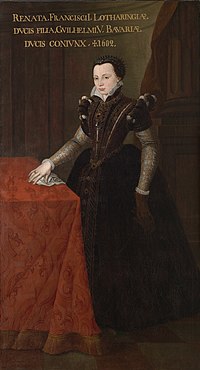Renata of Lorraine (French: Renée de Lorraine, German: Renata von Lothringen) (20 April 1544 – 22 May 1602) was a French noblewoman of the House of Lorraine who became a Duchess of Bavaria by her marriage to Duke William V.
| Renata of Lorraine | |
|---|---|

Portrait by Hans von Aachen
| |
| Duchess consort of Bavaria | |
| Tenure | 24 October 1579 - 15 October 1597 |
| |
| Born | Renée de Lorraine (1544-04-20)20 April 1544 Nancy, Duchy of Lorraine |
| Died | 22 May 1602(1602-05-22) (aged 58) Munich, Duchy of Bavaria |
| Spouse | William V, Duke of Bavaria |
| Issue |
|
| House | Lorraine |
| Father | Francis I, Duke of Lorraine |
| Mother | Christina of Denmark |
Born in Nancy, Renata was the second child and eldest daughter of Francis I, Duke of Lorraine[1] and Christina of Denmark.[2]
Renata was described as a beauty and a desirable match. In 1558, after the death of his first wife Prince William of Orange expressed a desire to marry Renata. Her mother, Christina, liked the idea, and it was further cemented after the Treaty of Cateau-Cambrésis. This match was however prevented by King Philip of Spain.[3] Christina declined the plan of Cardinal of Lorraine to arrange a marriage between Renata and the prince of Joinville, and also a match proposed by the Spanish king to marry Renata to Juan d'Austria.[3]
In 1561, Renata's mother planned to marry her to king Frederick II of Denmark. However, the outbreak of the Nordic Seven Years' War between Denmark and Sweden in 1563, interrupted these plans. From 1565 to 1567, Christina negotiated with King Eric XIV of Sweden to create an alliance between Sweden and Denmark through his marriage to Renata. The plan was for Christina to conquer Denmark with the support of Sweden, a plan Eric supported.[3]
However, Holy Roman Emperor Ferdinand opposed the plan due to the destructive effect it could have on the balance of power among the German nations, if Saxony (being strongly allied with Denmark) opposed Christina's claims. Neither did she manage to acquire the support of Philip of Spain. The planned marriage alliance between Lorraine and Sweden was finally ended when Eric XIV married his non-noble lover Karin Månsdotter in 1567.[3]
Finally, on 22 February 1568, Renata married her paternal second, but maternal first cousin William, hereditary prince of Bavaria,[4] in a large, elaborate ceremony and celebration in Munich that lasted 18 days. The event was described in detail by Massimo Troiano in his Dialoghi (1569). Approximately 5,000 riders took part in it, and the music was composed by Orlande de Lassus.[5]
Despite their large wedding and status, Renata, along with her husband, led a life of charity and humility. They left the Munich Residenz and lived in the Jesuit Kollegienbau west of Munich. Renata cared for the sick, the poor and religious pilgrims. In this task, she was completely supported by her husband. They had ten children, but only six of them lived to adulthood.
After her husband inherited the duchy in 1579 as William V of Bavaria, Renata spent much of her time in the Herzogspitalkirche in Munich, founded in 1555 by her father-in-law. She died in Munich, aged 58. Her grave is located in the St. Michael's Church in Munich, the consecration of which was the last high point in both her and her husband's lives. She was revered as a saint by the people, but never canonized. Her husband, who abdicated in 1597, survived her by twenty-four years, dying in 1626.
All current monarchs of the three Scandinavian countries (Harald V of Norway, Carl XVI Gustaf of Sweden and Margrethe II of Denmark) are Renata's direct blood descendants. Other direct descendants included Josephine of Leuchtenberg, who married the future King Oscar I of Sweden and Norway in 1823; Charles XV of Sweden and Norway who ascended the throne in 1859; Franz Josef of Austria; Maximilian I of Mexico; and Christian X of Denmark, who ascended the throne in 1912, among other numerous descendants.
Renata and William had:
Renata of Lorraine Born: 20 April 1544 Died: 22 May 1602 | ||
| Royal titles | ||
|---|---|---|
| Preceded by | Duchess consort of Bavaria 1579–1597 |
Succeeded by |